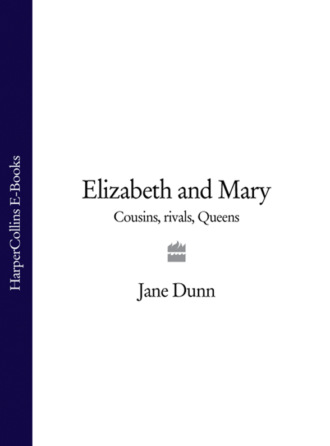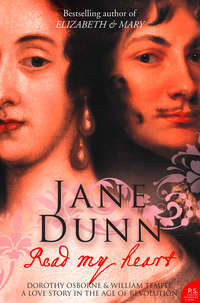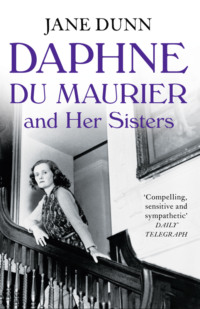
Полная версия
Elizabeth and Mary: Cousins, Rivals, Queens

ELIZABETH
AND
MARY
Cousins, Rivals, Queens
JANE DUNN

DEDICATION
In memory of a much loved father
DAVID ROLF THESEN
1923–2002
‘out of the strong came forth sweetness’
CONTENTS
Title Page
Dedication
Chronology
Preface
1 The Fateful Step
2 The Disappointment of Kings
3 The Education of Princes
4 Apprenticeship for a Queen
5 Wilfulness and God’s Will
6 Complicity and Competition
7 Raison de Coeur: Raison d’État
8 Seeking a Future King
9 Outrageous Fortune
10 Double Jeopardy
11 Singular Foes
12 The Consequence of the Offence
Select Bibliography
Index
P.S.
About the Author
About the Book
Read On
Acknowledgements
About the Author
Author’s Note
Notes
By the Same Author
Copyright
About the Publisher
PREFACE
Four hundred years ago, on 24 March 1603, Elizabeth I died. She was in her seventieth year. Having been propped for days on cushions on the floor in her chamber, she had been persuaded to take to her bed at last. To her Archbishop of Canterbury, silencing his praise, she said, ‘My lord, the crown which I have borne so long has given enough of vanity in my time.’ These words struck to the heart of the tragedy that had befallen Elizabeth and Mary Queen of Scots. This same crown had been the focus of Mary’s ambition too; her claim to Elizabeth’s throne was the obsession of her adult life from which so many disasters flowed.
Elizabeth realized that her crown and all the powerful interests that surrounded it were what drew her and Mary together, and yet fatally divided them. Despite possessing the throne of England, with all the pride of a daughter of King Henry, she was haunted by a deep-rooted insecurity as to her own legitimacy. When pressed by Parliament to sign Mary’s death warrant, Elizabeth railed in anguish against the crown that had made this unnatural decision hers alone. Instead she wished that Mary and she ‘were but as two milkmaids with pails upon our arms’, and she regretted, ‘that there were no more dependency upon us but mine own life were only in danger and not the whole estate of [her people’s] religion and well-doings’. It was their royal rather than their human status that had brought these queens to such straits that one had to die.
Sixteen years before Elizabeth’s own natural death in old age, Mary was beheaded at the age of forty-four. From that one act of regicide, a queen killing a fellow queen, a mythology of justification, romance, accusation and blame has been spun that retains its force to the present day. Of all the monarchs of these islands it is Elizabeth I and Mary Queen of Scots who most stir the imagination. They divided powerful opinion in their lifetimes and were the focus of passionate debate in the centuries that followed their deaths. Murderess, ‘whore’, daughter of the devil were epithets flung at both queens by their detractors, while their supporters claimed Elizabeth as hero and saviour, Mary as martyr and saint. It was the relationship between them that heightened these extremes of partisan feeling. Even in death, through history and myth, they continued locked together in complex rivalry, somehow embodying the ancestral character and mutual suspicion of their respective kingdoms.
In this new millennium, people identify with each queen still, arguing their merits and failures, and thinking they see some likeness in themselves. Elizabeth, the Virgin Queen, arguably the greatest monarch we have ever had, is certainly the one who most attracts superlatives. Unfashionable in her belief in self-discipline and sacrifice, she is irresistible as a reminder of England’s past glory and pre-eminence in the world: a phenomenon of her own making, without precedent or successor. And Mary, a queen celebrity, femme fatale and flawed heroine, valuing pleasure over duty and adventure most of all. She even cast her kingdom away for illicit love – what more modern sacrifice could there be? Finally, the brilliant coup de thêatre of her death opened a path back to redemption.
And I myself am far from immune from this fascination. When I opened the volumes of State Papers covering their reigns I was amazed by the vivid immediacy of the voices. Both queens, their ambassadors and ministers, all speak to us through the centuries with more forthright, revealing and affecting language than one would ever expect from official documents today. From letters, speeches, prayers, poems, diplomatic dispatches and ministers’ reports, the queens’ voices would explain themselves. By placing them centre stage and writing of their relationship with each other and the world, there was more space to explore their characters through their own words and those of their contemporaries.
Consequently, this is not a dual biography of these queens. Instead it is a kind of hybrid, about historical figures but not a history charting every aspect and incident of their lives. Chronological, but not strictly so, it follows the dynamic interaction which shifted as each queen took the initiative by turns, one never entirely dominant, each highly aware of the other. The balance of power was never clear cut: Elizabeth appeared to hold all the best cards, but Mary played those she had to disconcerting effect.
There are many fine biographies already of these most written-about queens: for Elizabeth, the classic J.E. Neale, and more recently Anne Somerset’s elegant, authoritative work, Alison Weir’s popular trilogy, and David Starkey’s vivid portrayal of the princess’s youth; for Mary, nothing has superseded in more than thirty years Lady Antonia Fraser’s impressive and sympathetic Life, although Jenny Wormald’s study of Mary as a monarch is marvellous. But the wealth of primary sources is so great that the scope for bringing new illumination to the story is almost boundless.
Elizabeth and Mary is about the relationship between the queens, one that seemed, during their lifetimes, to evolve a life of its own, and in the end hold both captive to it and each other. It was the most compelling relationship of their lives, affecting their political policy and personal attitudes. Unlike Elizabeth with Burghley and Leicester, or Mary with Moray, Darnley and Bothwell, this was a relationship neither had chosen, nor could escape, even in death. Elizabeth realized with some despair how their fates were intertwined: when she was ostensibly Mary’s jailer she declared, ‘I am not free, but a captive.’
The indissoluble bond between them was forged by two opposing forces; their shared inheritance and rivalry for Elizabeth’s crown set against their natural solidarity as regnant queens in an overwhelmingly masculine world. They had a fascination and sympathy for each other; they were cousins in an age when family mattered and when, for much of their lives, both lacked closer kin. Mary chose to emphasize her familial relationship with Elizabeth, her letters often supplicating, daughterly, even lover-like. ‘How much better’, she wrote to Elizabeth, ‘were it that we being two Queens so near of kin, neighbours and living in one isle, should be friends and live together like sisters, than by strange means divide ourselves to the hurt of both.’ And Elizabeth responded to these emotional pleas with a tone that was bossy, condescending and, for a while, elder-sisterly in her exasperated care. And yet they never met.
This is the great dramatic centre of their story. In the absence of reality a rival grows in stature in the imagination, becoming something superhuman, but also less than human and therefore easier to kill. Their failure to meet also became an expression of frustrated desire and control. Mary never gave up pleading for personal contact, certain that her charm would alter her case with her cousin. Initially willing, Elizabeth then grew increasingly distant and aloof, fearful of what she believed was Mary’s almost magical power to enchant, already exaggerated in her imagination and fuelled with the stories of others. Elizabeth was perplexed: ‘There is something sublime in the words and bearing of the Queen of Scots that constrains even her enemies to speak well of her.’
Part of the drama of their lives is this great opposition between their natures, their earliest experiences and the kinds of rulers they wished to be. All her life, Elizabeth had steeled herself to prove to the world she had the heart and mind of a man, so aware was she of the accepted inferiority of being merely female. She often boasted that in this masculinity her strength resided, yet she had all the passions of a woman, and expressed these most notably in her love for her favourites and her tenderness for her people. Mary was seen as recklessly emotional and liable to nervous collapse, and yet she showed a more ruthless resolve to see her sister queen murdered than Elizabeth could summon up for the judicial execution of Mary herself. So unlike in temperament, these queens nevertheless were well matched in the vigour of their ambitions and their obstinacy of purpose. The weapons they used were different, but each had just as great a capacity for harm.
In considering Elizabeth’s and Mary’s lives in relation to each other, illuminating symmetries occur. They both had remarkable mothers who, for different reasons, were lost to them. Anne Boleyn was a clever woman, radical in her Protestant sympathies, courageous and spirited, but a stranger to her daughter through death, and erased through the dangers inherent even in her memory. Mary of Guise, redoubtable queen and role model for Mary, but largely absent and unknown, due to the dynastic ambitions that made both mother and daughter exiles in each other’s land.
Each queen was involved in scandal over a favourite possibly implicated in murder, but they dealt with the crises they faced in completely different ways: Elizabeth’s action safeguarded her throne and gave her the moral foundation from which to impose her future authority; Mary’s decision lost her not only the throne but her freedom, and eventually her life. In the early years of Elizabeth’s reign it was the English queen who was consistently compared by foreign ambassadors, to her detriment, with her cousin, the Queen of Scotland. Elizabeth was the intractable monarch, the wanton queen, while Mary lived a model life as dauphine, then queen, then dowager queen of the great kingdom of France. Her return to Scotland marked the beginning of the adventures that would reverse these comparisons in epic fashion.
From that moment the tension in their relationship mounted. There was a struggle for supremacy and a desire in each to claim the moral high ground. Mary’s marriage and the birth of her son confirmed her conformity with expectations of what it was to be a good queen, while Elizabeth continued to prevaricate and evade her duty to provide for the succession. Then with Mary’s rumoured involvement in the murder of her husband and marriage to the likely murderer, heedless of Elizabeth’s trenchant advice, she set the English and Continental courts agog. There followed civil war in Scotland and humiliation for Mary, then imprisonment, fear for her life, miscarriage, forced abdication, night-time escape and precipitate flight to England. A plaintive existence as a genteel prisoner for seventeen years was enlivened with various plots to attain her freedom, and even her eventual elevation to the throne of England.
Even in death Mary sought to wrong-foot Elizabeth. Found guilty of incitement to kill her cousin, she went to her execution nobly insisting she was sacrificed for her faith alone. By dying heroically as a Catholic martyr, she rescued her reputation from the wreckage of her life. Elizabeth, as an old queen dying after more than four decades of transforming rule, was aware instead of the galloping hooves of the messenger’s horse riding north. The next incumbent of her jealously guarded throne would be Mary’s son, James, King of Scotland and now King of England too. This would mark Mary’s final triumph, the succession of the Tudors by the Stuarts. But there was triumph for Elizabeth too, for Mary’s son ruled their newly united kingdoms as a Protestant state.
The story of Elizabeth’s and Mary’s relationship is punctuated with reversals of fortune: murder mysteries, sexual intrigue, reckless behaviour, avowals of affection, heated battles and cold war. Fear, heartbreak and tragedy were its underlying strain. Yet surging through natural barriers of prejudice, masculine perspective and vested interest, these two queens emerge evergreen in their importance and fascination: Elizabeth, regardless of her weaknesses, confounding every prejudice against women in power; and Mary, despite her strengths, fulfilling in the end every foreboding, but with astounding boldness and abandon. They are welcome exceptions in the vast congregation of men who jostle for space in their domination of history.
That these two remarkable queens should have been contemporaries, neighbours in one small island, is gift enough for any writer. That they should be united by blood but inextricably enmeshed in a deadly rivalry for the same kingdom, the same throne, gives the story of their relationship the brooding force of Greek tragedy.
I came to this book as a biographer not a historian, believing that character largely drives events, explains motivation, and connects us to each other through the centuries. These queens lived lives vastly different from our own, but they behaved and felt in a way fundamentally familiar to us now. The outbursts of defiance, the flagging spirit, the pride in achievement and longing for love, all this is expressed in their own clear voices, as are the less familiar qualities of kingly pride, autocratic power and bloody revenge.
As a biographer one lives for years exploring the world and the mind of a stranger. For me in this case it was two strangers. Yet in those years these strangers gain a certain sense of intimacy and their lives a foothold in one’s own. In living so closely with these queens, inevitably my ideas and prejudices have changed. I became more aware of the profound loneliness of their role; the fear, the danger and responsibility were daunting, yet they accepted this and even revelled in it. The physical suffering and discomfort of their everyday lives was overlaid with such magnificent show and animated with an enormous zest and appetite for life itself. Above all, it is their characters that have gripped me, with their different energies and ambitions, their distinctive voices and the complexity of their human responses and feelings.
Mary was clearly a passionate and impetuous woman, but with a personal charm so disconcerting that even Elizabeth feared to meet her. She emerges a more intelligent and subtle thinker than I had initially thought her to be, and with a courage and energy in action that was breathtaking; her ruthlessness and desire for revenge more Medicean than Stuart in its lack of compromise or pity. Elizabeth, so obviously crafty, clever, and in imperial command of herself and others, also surprised with how tentative she could be, how affectionate, tender, and full of humour and charm. I hope that in these pages will be found some sense of that vitality; that through their own words, and the exploration of their relationship, we can look anew at these remarkable women and redoubtable queens.
Конец ознакомительного фрагмента.
Текст предоставлен ООО «ЛитРес».
Прочитайте эту книгу целиком, купив полную легальную версию на ЛитРес.
Безопасно оплатить книгу можно банковской картой Visa, MasterCard, Maestro, со счета мобильного телефона, с платежного терминала, в салоне МТС или Связной, через PayPal, WebMoney, Яндекс.Деньги, QIWI Кошелек, бонусными картами или другим удобным Вам способом.




